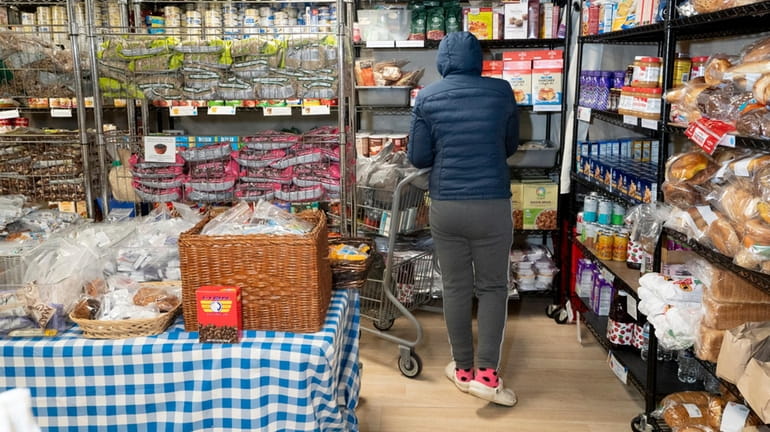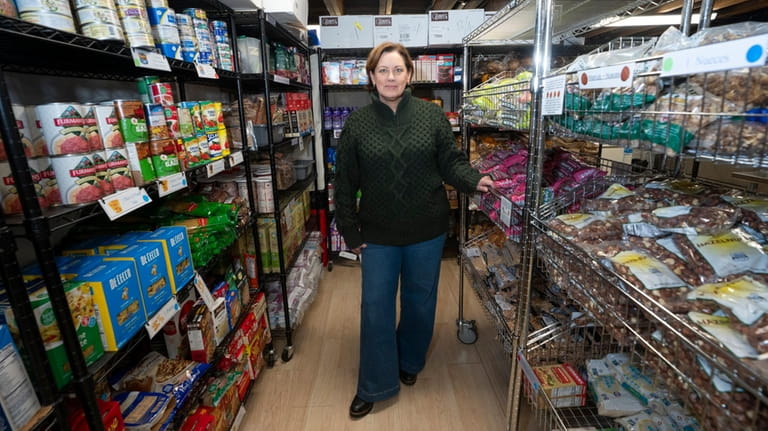Long Island nonprofits feel a chill in charitable giving

A woman shops at the Center for Advocacy, Support and Transformation in Southold on Tuesday. The nonprofit is in need of funding after a loss of government funding, inflation and growing demand. Credit: Randee Daddona
A food pantry in Southold keeps people coming to get essential items such as eggs, fresh produce and milk, but nonprofit leaders there are growing worried about keeping up with the rising demand for their services.
The Center for Advocacy, Support and Transformation, the nonprofit that runs the pantry and other initiatives to serve low-income individuals and families, has seen a dip in charitable giving coupled with a loss of COVID-19 government funding. Now, it's facing more than a $200,000 shortfall.
To help make up the difference, the nonprofit is considering reducing food distribution for families from once a week to twice a month. At the same time, it anticipates serving more than 400,000 meals this year, the most since the start of the organization in 1965. The previous high was before the pandemic began, in 2019, when roughly 40,000 to 45,000 meals were served.
"We're continuously growing at an alarming rate, and I don't see it letting up anytime soon," said Cathy Demeroto, executive director of the nonprofit, which hopes donors will step up to fill the funding gap.
The Southold-based nonprofit is not alone in feeling the squeeze. Others are facing economic hardships, threatening to further strain an already fragile safety net with their possible closure or reduction of services, experts in the nonprofit industry say.
"There are just a lot of nonprofits in a really precarious space right now, which then has a really negative effect on the people who they serve, in that these nonprofits don't have the resources to help everyone turning to them for help," said Rick Cohen, chief communication officer and chief operating officer at the Washington, D.C.-based National Council of Nonprofits.
Among the signs of trouble:
Nearly 70% of nonprofits that participated in a survey this year said they expected charitable giving to decrease or remain the same, the National Council of Nonprofits said, Roughly the same percentage anticipated the number of donors would shrink or remain the same, Last year, total giving to charities in the United States dropped 3,4% in current dollars to roughly $500 billion from 2021, the fourth time in 40 years that giving has decreased, according to a report from Giving USA, The other years were 1987, 2008 and 2009, Giving Tuesday, an important day of fundraising that lands on the Tuesday after Thanksgiving, saw 10% fewer adults — 34 million — give on that day compared to a year ago, according to the GivingTuesday nonprofit organization, Nationally, giving rose during those 24 hours this year by just 0,6% from the roughly $3 billion last year, the organization said, .
Yet, some in the nonprofit community hope there will be a boost in fundraising in the last part of the year.
Marie Smith, director of donor relations and communications at the Long Island Community Foundation, a grantmaking foundation affiliated with The New York Community Trust, said much of the donating many charities depend on happens in the last quarter of the year. Still, she noted, nonprofits have needed help raising funds amid the high inflationary climate.
"They have seen a decrease in fundraising," she said. "But again, we're hoping that optimistically, you know, it's going to be good this year with the inflation cooling."
Some organizations also remain optimistic about the giving outlook for 2023.
Fidelity Charitable, a Boston-based public charity that is a top grant-maker in the United States, said 87% of people who plan to support charities with their money intend to give an equal amount or more than they did last year, according to its survey of more than 1,000 people.
Meanwhile, Vanguard Charitable, a Pennsylvania-based nonprofit that sponsors donor-advised funds, said giving was up 5% during 2022 and more than $2 billion in grants have been awarded to charities since October.
A donor-advised fund can allow people to get an immediate tax deduction on funds that they can later recommend as grants to a charity, experts say.
"Because our donors were giving with a donor-advised fund, that money was already earmarked for charity, and they can continue to give more and more as needed," said Elaine Kenig, the organization's chief communications officer.
Other Long Island nonprofits that feel the difference in the climate for charities are trying to adjust.
The Bridgehampton Child Care & Recreational Center, a full-service community center that serves marginalized children and their families, said it's expanding but has seen difficulties in attracting new donors.
"A lot of our donors that we've had for many, many years — like, you know, 20 years, 30 years ago — now some of them are no longer here or, you know, just not in the positions that they can give as they did before," said Bonnie Cannon, the center's executive director.
Shannon Boyle, executive director of New Ground Inc., which seeks to break the cycle of homelessness and poverty among veterans and families on Long Island, said the Levittown-based nonprofit is working to diversify its revenue streams.
Before 2018, the organization mainly relied on individuals, corporations and foundations. This year, its revenue is budgeted at $950,000, with about 20% coming from grants and 4% from state funding. The remainder consists of support from individuals and corporations.
Boyle said revenue diversification is vital to the nonprofit's success in times of economic hardship. "So that way, if one of those funding streams, like individual donors, falls short because we're going through harder financial times, it's not making up such a big piece of your pie," she said.
"You've got your other funding streams that can hopefully step up and fill the gap," she said.
But for others, it's too late to change course. Project Safety Net NY, a Patchogue-based nonprofit that serves people who have HIV and deal with substance abuse and other needs, could not overcome a loss in critical grants from the government during the pandemic and is set to close this month.
Colin Pearsall, Project Safety Net NY's executive director, said the organization for years had a yearly deficit of more than $500,000 until it could no longer provide critical services.
Pearsall said much of their operations have been outsourced to other organizations. Many of the staff of about 40 they had in January have gotten other jobs, and the vans they used for mobile testing have been donated to other organizations.
There is a loss of insight and expertise when a local nonprofit's door closes, Pearsall said. For instance, there is often not someone there with the institutional knowledge about the parking lot where people hang out and need assistance, or the bar where people are at greater risk.
"Once a small local nonprofit goes away, no one really understands the local community, and like, really, where the pockets of risk are," he said.
A food pantry in Southold keeps people coming to get essential items such as eggs, fresh produce and milk, but nonprofit leaders there are growing worried about keeping up with the rising demand for their services.
The Center for Advocacy, Support and Transformation, the nonprofit that runs the pantry and other initiatives to serve low-income individuals and families, has seen a dip in charitable giving coupled with a loss of COVID-19 government funding. Now, it's facing more than a $200,000 shortfall.
To help make up the difference, the nonprofit is considering reducing food distribution for families from once a week to twice a month. At the same time, it anticipates serving more than 400,000 meals this year, the most since the start of the organization in 1965. The previous high was before the pandemic began, in 2019, when roughly 40,000 to 45,000 meals were served.
"We're continuously growing at an alarming rate, and I don't see it letting up anytime soon," said Cathy Demeroto, executive director of the nonprofit, which hopes donors will step up to fill the funding gap.
WHAT TO KNOW
- Some nonprofits are facing a squeeze that may impact their ability to provide critical services to the communities they serve.
- Nearly 70% of nonprofits that participated in a 2023 survey said they expected charitable giving would decrease or remain the same, the National Council of Nonprofits said.
- Giving Tuesday, an important day of fundraising that lands on the Tuesday after Thanksgiving, saw 10% fewer adults — 34 million — give on that day compared to a year ago, according to the GivingTuesday nonprofit organization.
The Southold-based nonprofit is not alone in feeling the squeeze. Others are facing economic hardships, threatening to further strain an already fragile safety net with their possible closure or reduction of services, experts in the nonprofit industry say.

Executive director Cathy Demeroto at the pantry run by the Center for Advocacy, Support and Transformation. Credit: Randee Daddona
"There are just a lot of nonprofits in a really precarious space right now, which then has a really negative effect on the people who they serve, in that these nonprofits don't have the resources to help everyone turning to them for help," said Rick Cohen, chief communication officer and chief operating officer at the Washington, D.C.-based National Council of Nonprofits.
Among the signs of trouble:
- Nearly 70% of nonprofits that participated in a survey this year said they expected charitable giving to decrease or remain the same, the National Council of Nonprofits said. Roughly the same percentage anticipated the number of donors would shrink or remain the same.
- Last year, total giving to charities in the United States dropped 3.4% in current dollars to roughly $500 billion from 2021, the fourth time in 40 years that giving has decreased, according to a report from Giving USA. The other years were 1987, 2008 and 2009.
- Giving Tuesday, an important day of fundraising that lands on the Tuesday after Thanksgiving, saw 10% fewer adults — 34 million — give on that day compared to a year ago, according to the GivingTuesday nonprofit organization. Nationally, giving rose during those 24 hours this year by just 0.6% from the roughly $3 billion last year, the organization said.
Hoping for a late-year boost
Yet, some in the nonprofit community hope there will be a boost in fundraising in the last part of the year.
Marie Smith, director of donor relations and communications at the Long Island Community Foundation, a grantmaking foundation affiliated with The New York Community Trust, said much of the donating many charities depend on happens in the last quarter of the year. Still, she noted, nonprofits have needed help raising funds amid the high inflationary climate.
"They have seen a decrease in fundraising," she said. "But again, we're hoping that optimistically, you know, it's going to be good this year with the inflation cooling."

Produce at the pantry run by the Center for Advocacy, Support and Transformation. Credit: Randee Daddona
Some organizations also remain optimistic about the giving outlook for 2023.
Fidelity Charitable, a Boston-based public charity that is a top grant-maker in the United States, said 87% of people who plan to support charities with their money intend to give an equal amount or more than they did last year, according to its survey of more than 1,000 people.
Meanwhile, Vanguard Charitable, a Pennsylvania-based nonprofit that sponsors donor-advised funds, said giving was up 5% during 2022 and more than $2 billion in grants have been awarded to charities since October.
A donor-advised fund can allow people to get an immediate tax deduction on funds that they can later recommend as grants to a charity, experts say.
"Because our donors were giving with a donor-advised fund, that money was already earmarked for charity, and they can continue to give more and more as needed," said Elaine Kenig, the organization's chief communications officer.
Nonprofits adapt — if they can
Other Long Island nonprofits that feel the difference in the climate for charities are trying to adjust.
The Bridgehampton Child Care & Recreational Center, a full-service community center that serves marginalized children and their families, said it's expanding but has seen difficulties in attracting new donors.
"A lot of our donors that we've had for many, many years — like, you know, 20 years, 30 years ago — now some of them are no longer here or, you know, just not in the positions that they can give as they did before," said Bonnie Cannon, the center's executive director.
Shannon Boyle, executive director of New Ground Inc., which seeks to break the cycle of homelessness and poverty among veterans and families on Long Island, said the Levittown-based nonprofit is working to diversify its revenue streams.
Before 2018, the organization mainly relied on individuals, corporations and foundations. This year, its revenue is budgeted at $950,000, with about 20% coming from grants and 4% from state funding. The remainder consists of support from individuals and corporations.
Boyle said revenue diversification is vital to the nonprofit's success in times of economic hardship. "So that way, if one of those funding streams, like individual donors, falls short because we're going through harder financial times, it's not making up such a big piece of your pie," she said.
"You've got your other funding streams that can hopefully step up and fill the gap," she said.
But for others, it's too late to change course. Project Safety Net NY, a Patchogue-based nonprofit that serves people who have HIV and deal with substance abuse and other needs, could not overcome a loss in critical grants from the government during the pandemic and is set to close this month.
Colin Pearsall, Project Safety Net NY's executive director, said the organization for years had a yearly deficit of more than $500,000 until it could no longer provide critical services.
Pearsall said much of their operations have been outsourced to other organizations. Many of the staff of about 40 they had in January have gotten other jobs, and the vans they used for mobile testing have been donated to other organizations.
There is a loss of insight and expertise when a local nonprofit's door closes, Pearsall said. For instance, there is often not someone there with the institutional knowledge about the parking lot where people hang out and need assistance, or the bar where people are at greater risk.
"Once a small local nonprofit goes away, no one really understands the local community, and like, really, where the pockets of risk are," he said.

